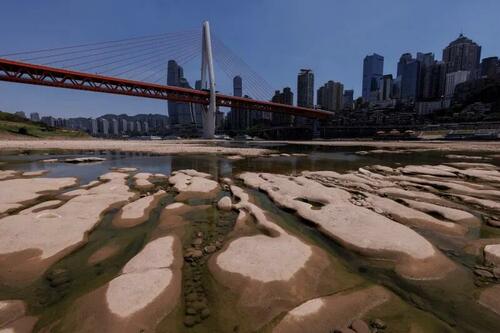
China's water crisis is nothing new, but it's gotten worse - and is now on the 'brink of catastrophe' and could trigger a global catastrophe, according to Foreign Affairs.

Thomas Peter / Reuters
Given the country’s overriding importance to the global economy, potential water-driven disruptions beginning in China would rapidly reverberate through food, energy, and materials markets around the world and create economic and political turbulence for years to come. -Foreign Affairs
For starters, there's no substitute for water - which is essential for food production, electricity generation and sustaining all life on earth.
In China, which consumes ten billion barrels of water per day (approximately 700x its daily oil consumption), decades of economic and population growth have pushed northern China's water system to unsustainable levels.
According to the report, the per-capita water supply around the North China Plain at the end of 2020 was nearly 50% below the UN's definition of acute water scarcity at 253 cubic meters. Other major cities, including Beijing, Shanghai, Tianjin, are at similar (or lower) levels.
For comparison, Egypt had per-capita freshwater resources of 570 cubic meters, and has nowhere near as large of a manufacturing base as China.
Not fit for human consumption
Also worrisome, is that 19% of China's surface water is not fit for human consumption according to China’s Ministry of Ecology and Environment. Roughly 7% was deemed unfit for any use at all.
Groundwater was worse - with around 30% considered unfit for consumption, and 16% unfit for any use.
In order to utilize this water, Beijing will need to make major investments in treatment infrastructure, which will require a significant increase in electricity usage in order to power the equipment.
Working against progress is China's farming and industrial industries, which dump contaminants into the country's groundwater - potentially setting the stage for decades of additional impairments.
Data from the UN Food and Agriculture Organization indicate that China uses nearly two and a half times as much fertilizer and four times as much pesticide as the United States does despite having 25 percent less arable land.
For decades, Beijing has generally chosen to conceal the full extent of China’s environmental problems to limit potential public backlash and to avoid questions about the competence and capacity of the Chinese Communist Party (CCP). This lack of transparency suggests that an escalation to acute water distress could be far closer than most outside observers realize—increasing the chances that the world will be ill prepared for such a calamity. -Foreign Affairs
The core problem is the overpumping of aquifers under the Northern China Plain - which according to NASA GRACE satellites, are more overdrawn than those of the Ogallala Aquifer under the Great Plains in the US - which is one of the world's most imperiled sources of agricultural water.
In some instances, groundwater levels have gotten so low that underground aquifers have collapsed - triggering a phenomenon called Land Subsidence, which can cause the ground to cave in over large areas, which in some case renders the aquifer unusable in the future.
In 2003, Beijing launched a $60 billion "South-to-North Water Transfer Project" to use waters from the Yangtze River to replenish the north.
Meanwhile, China has deployed cloud seeding technologies to lace the clouds with silver iodide or liquid nitrogen in order to stimulate rainfall. It's also relocated heavy industries away from dry regions.
In April 2022, Vice Minister of Water Resources Wei Shanzhong estimated that China could end up spending $100 billion annually on water-related projects.
It might not be enough, however.
Despite highly innovative programs to improve water availability, some scholars estimate that water supply could fall short of demand by 25 percent by 2030—a situation that would by definition force major adjustments in society. Experiences to date on the North China Plain enhance concern and illustrate the scale of additional needed hydraulic intervention. Despite nearly a decade of importing Yangtze valley water supplies to high-stress areas such as Beijing, large-scale depletion of stored groundwater continues in other nearby areas, such as Hebei and Tianjin. -Foreign Affairs
The result of a worsening drought will, of course, mean less food.
60% of China's wheat, 45% of its corn, 35% of its cotton and 64% of its peanuts come from the at-risk North China Plain - where, in the example of wheat, their annual production of more than 80 million tons is on par with Russia's annual output, while their 125 million tons of corn is nearly 3x Ukraine's prewar production.
In order to sustain these harvests, water is being pumped to farms faster than nature can replenish it. According to satellite data, between 2003 and 2010, Northern China lost as much groundwater as Beijing consumes annually - leaving farmers struggling to find new sources.
If the North China Plain suffers a 33% crop loss due to water insufficiency, China would need to import roughly 20% of the world's internationally traded corn and 13% of the world's wheat.
Although China has stockpiled the world’s largest grain reserves, the country is not immune to a multiyear yield shortfall. This would likely force China’s food traders, including large state-owned enterprises such as COFCO and Sinograin, into global markets on an emergency basis to secure additional supplies. This in turn could trigger food price spikes in high-income countries, while rendering key food items economically inaccessible to hundreds of millions of people in poorer countries. The impacts of this water-driven food shortage could be far worse than the food-related unrest that swept across lower- and middle-income countries in 2007 and 2008 and would drive migration and exacerbate political polarization already present in Europe and the United States. -Foreign Affairs
A shocking problem
China's water woes go beyond agriculture - with around 90% of the country's electrical grid reliant on extensive water resources - "particularly hydro, coal, and even nuclear generation, which needs large and steady water supplies for steam condensers and to cool reactor cores and used fuel rods" according to the report.
If China lost 15% of its hydropower production in any given year due to low water levels, it would have to increase electricity output via other means by an amount equal to what Egypt consumes in a year - something that only coal would be able to accomplish.
Except - the process of mining and preparing coal is also highly water intensive. And while seawater can be used to cool the limited coastal coal sources, much of the sooty resource is located inland and rely on groundwater, rivers and lakes.
Read the rest here...
China’s water crisis is nothing new, but it’s gotten worse – and is now on the ‘brink of catastrophe‘ and could trigger a global catastrophe, according to Foreign Affairs.

Thomas Peter / Reuters
Given the country’s overriding importance to the global economy, potential water-driven disruptions beginning in China would rapidly reverberate through food, energy, and materials markets around the world and create economic and political turbulence for years to come. -Foreign Affairs
For starters, there’s no substitute for water – which is essential for food production, electricity generation and sustaining all life on earth.
In China, which consumes ten billion barrels of water per day (approximately 700x its daily oil consumption), decades of economic and population growth have pushed northern China’s water system to unsustainable levels.
According to the report, the per-capita water supply around the North China Plain at the end of 2020 was nearly 50% below the UN’s definition of acute water scarcity at 253 cubic meters. Other major cities, including Beijing, Shanghai, Tianjin, are at similar (or lower) levels.
For comparison, Egypt had per-capita freshwater resources of 570 cubic meters, and has nowhere near as large of a manufacturing base as China.
Not fit for human consumption
Also worrisome, is that 19% of China’s surface water is not fit for human consumption according to China’s Ministry of Ecology and Environment. Roughly 7% was deemed unfit for any use at all.
Groundwater was worse – with around 30% considered unfit for consumption, and 16% unfit for any use.
In order to utilize this water, Beijing will need to make major investments in treatment infrastructure, which will require a significant increase in electricity usage in order to power the equipment.
Working against progress is China’s farming and industrial industries, which dump contaminants into the country’s groundwater – potentially setting the stage for decades of additional impairments.
Data from the UN Food and Agriculture Organization indicate that China uses nearly two and a half times as much fertilizer and four times as much pesticide as the United States does despite having 25 percent less arable land.
For decades, Beijing has generally chosen to conceal the full extent of China’s environmental problems to limit potential public backlash and to avoid questions about the competence and capacity of the Chinese Communist Party (CCP). This lack of transparency suggests that an escalation to acute water distress could be far closer than most outside observers realize—increasing the chances that the world will be ill prepared for such a calamity. -Foreign Affairs
The core problem is the overpumping of aquifers under the Northern China Plain – which according to NASA GRACE satellites, are more overdrawn than those of the Ogallala Aquifer under the Great Plains in the US – which is one of the world’s most imperiled sources of agricultural water.
In some instances, groundwater levels have gotten so low that underground aquifers have collapsed – triggering a phenomenon called Land Subsidence, which can cause the ground to cave in over large areas, which in some case renders the aquifer unusable in the future.
In 2003, Beijing launched a $60 billion “South-to-North Water Transfer Project” to use waters from the Yangtze River to replenish the north.
Meanwhile, China has deployed cloud seeding technologies to lace the clouds with silver iodide or liquid nitrogen in order to stimulate rainfall. It’s also relocated heavy industries away from dry regions.
In April 2022, Vice Minister of Water Resources Wei Shanzhong estimated that China could end up spending $100 billion annually on water-related projects.
It might not be enough, however.
Despite highly innovative programs to improve water availability, some scholars estimate that water supply could fall short of demand by 25 percent by 2030—a situation that would by definition force major adjustments in society. Experiences to date on the North China Plain enhance concern and illustrate the scale of additional needed hydraulic intervention. Despite nearly a decade of importing Yangtze valley water supplies to high-stress areas such as Beijing, large-scale depletion of stored groundwater continues in other nearby areas, such as Hebei and Tianjin. -Foreign Affairs
The result of a worsening drought will, of course, mean less food.
60% of China’s wheat, 45% of its corn, 35% of its cotton and 64% of its peanuts come from the at-risk North China Plain – where, in the example of wheat, their annual production of more than 80 million tons is on par with Russia’s annual output, while their 125 million tons of corn is nearly 3x Ukraine’s prewar production.
In order to sustain these harvests, water is being pumped to farms faster than nature can replenish it. According to satellite data, between 2003 and 2010, Northern China lost as much groundwater as Beijing consumes annually – leaving farmers struggling to find new sources.
If the North China Plain suffers a 33% crop loss due to water insufficiency, China would need to import roughly 20% of the world’s internationally traded corn and 13% of the world’s wheat.
Although China has stockpiled the world’s largest grain reserves, the country is not immune to a multiyear yield shortfall. This would likely force China’s food traders, including large state-owned enterprises such as COFCO and Sinograin, into global markets on an emergency basis to secure additional supplies. This in turn could trigger food price spikes in high-income countries, while rendering key food items economically inaccessible to hundreds of millions of people in poorer countries. The impacts of this water-driven food shortage could be far worse than the food-related unrest that swept across lower- and middle-income countries in 2007 and 2008 and would drive migration and exacerbate political polarization already present in Europe and the United States. -Foreign Affairs
A shocking problem
China’s water woes go beyond agriculture – with around 90% of the country’s electrical grid reliant on extensive water resources – “particularly hydro, coal, and even nuclear generation, which needs large and steady water supplies for steam condensers and to cool reactor cores and used fuel rods” according to the report.
If China lost 15% of its hydropower production in any given year due to low water levels, it would have to increase electricity output via other means by an amount equal to what Egypt consumes in a year – something that only coal would be able to accomplish.
Except – the process of mining and preparing coal is also highly water intensive. And while seawater can be used to cool the limited coastal coal sources, much of the sooty resource is located inland and rely on groundwater, rivers and lakes.
Read the rest here…





